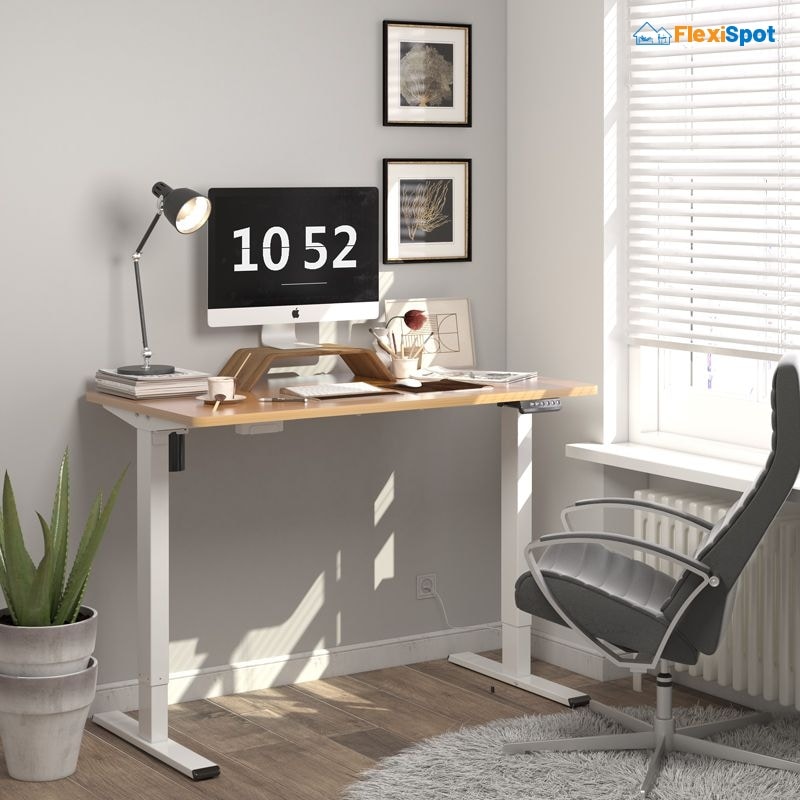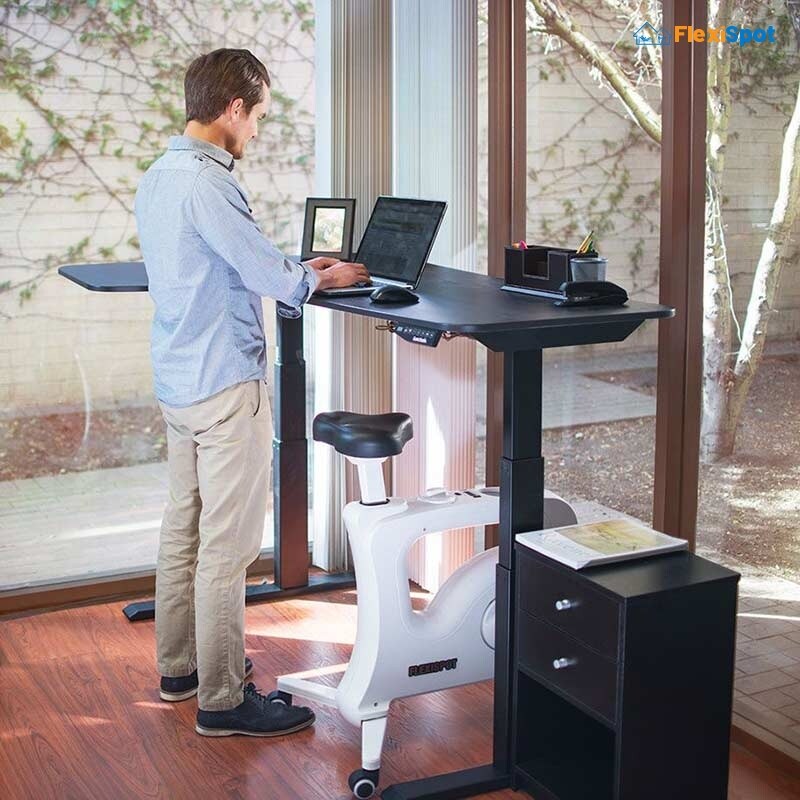We all know that sitting down for long periods of time is bad for our health. It increases the risk of obesity, heart disease, diabetes, and even death. But what many people don't realize is that standing up isn't necessarily the solution. In fact, if you don't do it right, standing can also be harmful to your health.
That's where ergonomics comes in. Ergonomics is the study of how people interact with their environment. It considers things like body size, strength, flexibility, and posture. Regarding standing desks, ergonomics can help you find the right desk height, monitor position, and keyboard placement to minimize the risk of injury. I'll be looking at a few ways through which standing desks can transform how people work.
The Importance of Standing Desk Ergonomics
Regarding standing desk ergonomics, you need to keep a few key things in mind to maintain good posture and avoid injury. First, make sure that your monitor is at eye level. Secondly, keep your keyboard and mouse within easy reach. And finally, adjust your chair height, so your feet are flat on the ground.
If you have a sit-stand desk or are considering getting one, here are a few things to keep in mind when it comes to ergonomics:
Monitor height: When setting up your monitor, ensure it’s at eye level. The top of the screen should be at or slightly below eye level. If you wear reading glasses, place the monitor an inch or two above your natural line of sight. This will help you avoid tilting your head back to see the screen, which can cause neck strain.
Keyboard and mouse: Keep your keyboard and mouse within easy reach so you don’t have to stretch to use them. When typing, your elbows should be at a 90-degree angle, and your wrists should be straight with your forearms. If you have to reach for the mouse, try using a wireless model or placing it on a book or other elevated surface so it’s closer to you.
Chair height: Adjust your chair height so that your feet are flat on the ground and your thighs are parallel to the floor. This will help you maintain good posture and avoid discomfort. If your chair is too low, you may find yourself slouching; if it’s too high, you may start to feel pain in your legs.
Standing desk ergonomics are important to consider if you want to avoid injury and maintain good posture. By following these simple tips, you can create a comfortable and efficient workspace.
How to Set Up Your Standing Desk
The standing desk is becoming increasingly popular as people realize the importance of staying active during the day. However, it's not enough to just buy a standing desk - you need to set it up correctly to reap the benefits. This is how you go about it.
1. The first step is to adjust the height of your standing desk. It should be at a level that is comfortable for you to work at without causing you any strain.
2. Once you have the correct height, it's time to focus on the positioning of your computer screen. It should be at eye level, so you don't have to strain your neck to look at it.
3. The next thing to do is to adjust the position of your keyboard and mouse. They should be within easy reach, so you don't have to stretch to use them.
4. Finally, ensure you have enough space to move around while you're working. You shouldn't feel cramped or uncomfortable while using your standing desk.
These simple steps will ensure you get the most out of your standing desk and avoid discomfort or strain. Remember, it's important to stay active during the day to boost your health and productivity - so make sure you set up your standing desk correctly.
The Benefits of Using a Standing Desk
It’s no secret that sitting all day is bad for your health. In fact, studies have shown that too much sitting can lead to a host of health problems, including obesity, heart disease, and even premature death.
So it’s no surprise that more and more people are looking for ways to reduce their time spent sitting. Standing desks are one popular solution, and for good reason: they offer several benefits over traditional desks.
Here are 8 benefits of using a standing desk:
They improve your posture: When you sit all day, your shoulders tend to round forward, and your head juts out. This can lead to upper back and neck pain. Standing desks help to improve your posture by keeping your shoulders back and your head aligned with your spine
They increase your energy levels: Sitting all day can make you feel sluggish and tired. Standing up gives you a much-needed energy boost, which can help you to be more productive throughout the day.
They burn more calories: While standing desks won’t help you lose weight on their own, they can help you to burn a few extra calories each day. In fact, one study found that people who used standing desks burned an average of 54 more calories per day than those who sat at traditional desks.
They reduce the risk of cardiovascular disease: Too much sitting has been linked to an increased risk of cardiovascular disease. One study found that people who sit for more than 11 hours a day have a 40% increased risk of dying from cardiovascular disease than those who sit for less than 4 hours a day.
They improve your mental health: Sitting all day can lead to feelings of anxiety and depression. Standing up and moving around can help improve your mood and reduce stress.
They increase your lifespan: A sedentary lifestyle has been linked to a shorter lifespan. In fact, one study found that people who sit for more than 6 hours a day have a 30% increased risk of dying prematurely than those who sit for less than 3 hours a day.
They lower your risk of cancer: Prolonged periods of sitting have been linked to an increased risk of several types of cancer, including colon, endometrial, and lung cancer. Standing up and moving around can help to reduce your risk of developing these cancers.
They boost your productivity: Standing up has improved focus and concentration and can even boost your creativity. A standing desk may be the answer if you’re looking for a way to increase your productivity.
If you’re considering a standing desk, it’s important to find one that’s comfortable and easy to use. Make sure to adjust the height so that it’s comfortable for you to stand at, and invest in a good pair of shoes to reduce fatigue.
With so many benefits, it’s no wonder that standing desks are becoming more popular. A standing desk may be the perfect solution if you’re looking for a way to improve your health and increase your productivity.
The Drawbacks of Using Standing Desks
You’re still not moving enough: Sitting for long periods is bad for your health, but standing for long periods isn’t much better. In fact, standing in the same spot for hours on end can lead to varicose veins, back pain, and other health problems. If you’re going to use a standing desk, make sure to take breaks often and move around as much as possible. Set a timer or alarm to remind yourself to move every 30 minutes.
You could end up with musculoskeletal disorders: Musculoskeletal disorders (MSDs) are injuries or pain in the muscles, tendons, or nerves. They can be caused by repetitive motions, awkward positions, or overexertion. Standing for long periods can put extra strain on your muscles and joints, leading to MSDs. If you already have a musculoskeletal disorder, using a standing desk could make it worse.
You might not be as productive: Many people think standing while they work will help them be more productive. But there’s no evidence to support this claim. In fact, one study found that people who used standing desks were no more productive than those who sat at their desks. If you’re looking for ways to increase your productivity, there are better methods than using a standing desk. For example, you could try using a standing desk for some tasks but sitting for others. Or you could take regular breaks to move around and stretch your body.
You could end up with neck and shoulder pain: If you use a standing desk without making any adjustments, you’re likely to end up with neck and shoulder pain. This is because you’ll look down at your work instead of keeping your head up and shoulders back. To avoid this problem, make sure to adjust your monitor so that it’s at eye level. You might also want to invest in a comfortable ergonomic chair or stool to use when you need a break from standing.
Conclusion
When used correctly, standing desks can greatly benefit your health. By promoting better posture and improving circulation, standing desks can help you stay healthy and productive. When choosing a standing desk, be sure to consider the ergonomics to ensure that it meets your needs. With a little bit of planning and effort, you can make standing desk ergonomics work for you.

















